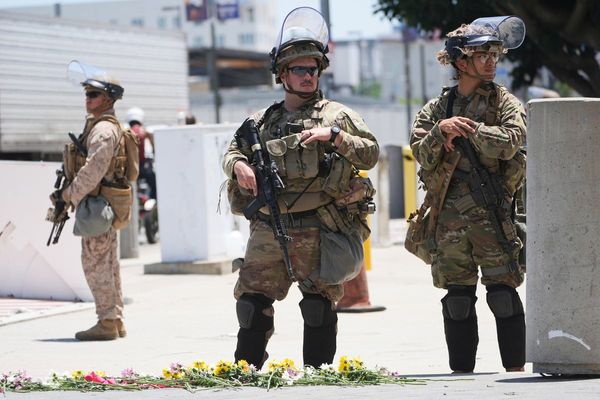
At least three people have been killed in Vietnam after Typhoon Kajiki battered northern and central areas of the country, bringing fierce winds and torrential rains that collapsed homes, felled trees and turned streets in the capital, Hanoi, into rivers.
The storm, which made landfall in Vietnam on Monday with winds of up to 130 kilometres per hour (80 miles per hour), also left at least 13 people wounded, authorities said on Tuesday.
It has now crossed into Laos and weakened into a tropical depression.
Vietnam’s government, in a statement, said Kajiki damaged nearly 7,000 homes, inundated 28,800 hectares (71,166 acres) of rice plantings and felled some 18,000 trees. It also brought down 331 electricity poles, causing widespread blackouts in Thanh Hoa, Nghe An, Ha Tinh, Thai Nguyen and Phu Tho provinces.
The country’s national weather agency forecast continued downpours through Tuesday, with some areas likely to get up to 150 millimetres (6 inches) of rain in six hours, potentially causing flash floods and landslides.
In Hanoi, local media reported that continued heavy rains have caused widespread flooding, submerging streets, stalling vehicles and snarling traffic.
According to VnExpress, the floodwaters on National Highway 6, which links Hanoi with northwestern provinces, reached nearly 1 metre (3.3 feet) in some places, stalling cars and motorbikes.
“It was impossible to move around this morning. My front yard is also flooded,” Nguyen Thuy Lan, 44, told the AFP news agency.
‘Absolutely terrifying’
In the central city of Vinh, one resident described the typhoon as “absolutely terrifying”.
Tran Van Hung, 65, told AFP that the storm blew a steel roof from the eighth floor of a building onto the middle of the street. “It was so lucky that no one was hurt,” Hung said.
Nguyen Thi Hoa, 60, described strong winds that filled the night air with the sound of “trees twisting and the noise of the flying steel panels”.
“We are used to heavy rain and floods, but I think I have never experienced that strong wind and its gust like this yesterday,” Hoa added.
Before the storm’s landfall, Vietnamese authorities evacuated some 44,000 people across five provinces and called all fishing boats back to harbour.
The military has also mobilised more than 346,000 personnel and 8,200 vehicles, including five aircraft, to support storm relief, according to Viet Nam News.
The military has instructed its troops to remain on high alert and prepare for rapid deployment in areas vulnerable to landslides and flash floods.
The United Nations children’s agency (UNICEF), meanwhile, issued a statement expressing deep concern over the increasing risks children face due to the repeated storms striking the region. The agency said children in East Asia and the Pacific now face climate hazards six times more often than their grandparents did, noting that Kajiki comes just about a month after the same communities in Vietnam were hit by Typhoon Wipha.
Kajiki is also the tenth typhoon to strike the region this year.
“With disasters striking so often, children and families barely have time to recover before their homes, schools, and sense of safety are disrupted again,” said June Kunugi, UNICEF regional director for East Asia and the Pacific. “Each new storm compounds the damage of the last, leaving children increasingly vulnerable.”
Scientists say human-caused climate change is driving more intense and unpredictable weather patterns that can make destructive floods and storms more likely, particularly in the tropics.
In Vietnam, more than 100 people have been killed or left missing from natural disasters in the first seven months of 2025, according to the Ministry of Agriculture and Rural Development.
Economic losses have been estimated at more than $21m.
Vietnam suffered $3.3bn in economic losses last September as a result of Typhoon Yagi, which swept across the country’s north and caused hundreds of deaths.
“Typhoon Yagi affected more than six million children through devastating floods and damaged schools; Kajiki now adds to these recurring shocks, heightening risks to children’s health, learning, and wellbeing,” UNICEF said.







